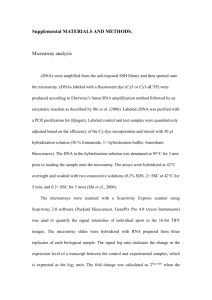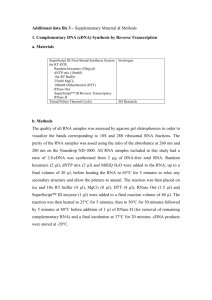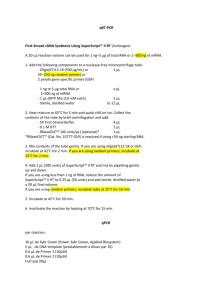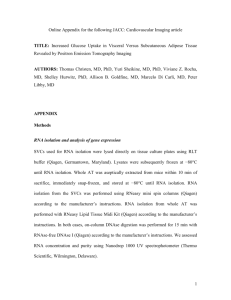Supplementary Information (doc 74K)
advertisement
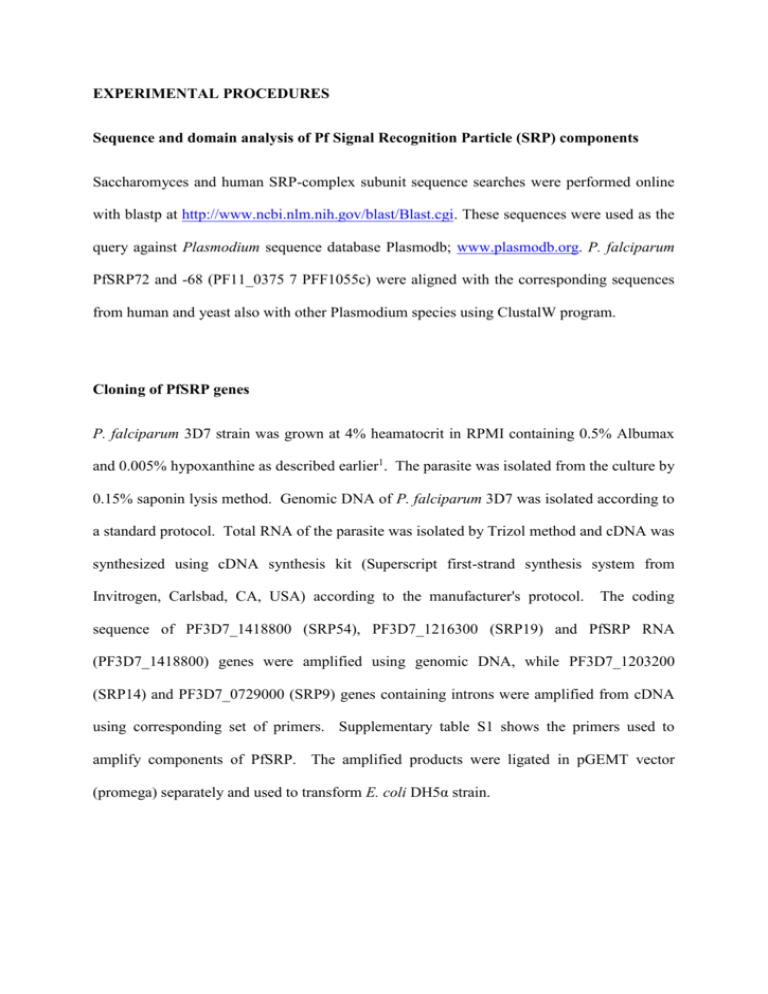
EXPERIMENTAL PROCEDURES Sequence and domain analysis of Pf Signal Recognition Particle (SRP) components Saccharomyces and human SRP-complex subunit sequence searches were performed online with blastp at http://www.ncbi.nlm.nih.gov/blast/Blast.cgi. These sequences were used as the query against Plasmodium sequence database Plasmodb; www.plasmodb.org. P. falciparum PfSRP72 and -68 (PF11_0375 7 PFF1055c) were aligned with the corresponding sequences from human and yeast also with other Plasmodium species using ClustalW program. Cloning of PfSRP genes P. falciparum 3D7 strain was grown at 4% heamatocrit in RPMI containing 0.5% Albumax and 0.005% hypoxanthine as described earlier1. The parasite was isolated from the culture by 0.15% saponin lysis method. Genomic DNA of P. falciparum 3D7 was isolated according to a standard protocol. Total RNA of the parasite was isolated by Trizol method and cDNA was synthesized using cDNA synthesis kit (Superscript first-strand synthesis system from Invitrogen, Carlsbad, CA, USA) according to the manufacturer's protocol. The coding sequence of PF3D7_1418800 (SRP54), PF3D7_1216300 (SRP19) and PfSRP RNA (PF3D7_1418800) genes were amplified using genomic DNA, while PF3D7_1203200 (SRP14) and PF3D7_0729000 (SRP9) genes containing introns were amplified from cDNA using corresponding set of primers. Supplementary table S1 shows the primers used to amplify components of PfSRP. The amplified products were ligated in pGEMT vector (promega) separately and used to transform E. coli DH5α strain. Parasite culture and transfection P. falciparum strains 3D7 were maintained in culture using O(+ve) human RBC (4% hematocrit) in RPMI1640 media (Invitrogen) supplemented with 10% Albumax (GibcoBRL) by standard procedure. To generate the transfection vector constructs, full length PfSRP9, PfSRP19, PfSRP54 and PfSRP14 genes were amplified from genomic DNA or cDNA using designed primers. Supplementary table S2 lists the primers synthesized to amplify PfSRP genes. The amplified fragments were digested with BamH1and AvrII and ligated with BglII and AvrII sites of pSSPF2 vector in frame with the eGFP sequence. The parasite cultures were synchronized by two consecutive sorbitol treatments at 4 hour interval following the protocol described previously by Lambros and Vanderberg2. Tightly synchronized ring stage parasites were collected by centrifugation and washed with incomplete cytomix. 200 µl parasites were resuspended in a suspension containing 370µl of incomplete cytomix and 30µl of plasmid DNA (100µg) and transfected by electroporation (310V, 950µF)3. After electroporation, parasites were immediately transferred to 10 ml of prewarmed complete culture medium supplemented with 200µl uninfected RBCs. The transfected parasites were selected on 2.5 nMol WR99210, an antifolate drug that selects the presence of human dhfr gene in plasmid. Expression and purification of proteins DNA fragments of intact PfSRP54, M-domain and NG-domain of PfSRP54 were released from pGEMT constructs by EcoRI/XhoI, BamHI/XhoI, and NcoI/XhoI digestion respectively. Each DNA fragment was ligated into the pET28a (Novagen, Madison, WI, USA) plasmid and digested with corresponding restriction enzymes. DNA fragments of PfSRP19, PfSRP14 and PfSRP9 were released from pGEMT constructs by NcoI/XhoI digestion. Each DNA fragment was ligated into the pET28b (Novagen, Madison, WI, USA), which was digested with NcoI/XhoI. The plasmid constructs were used to transform the E. coli BL21 PlysS gold. The positive clones were grown overnight in LB media, and the secondary culture of each clone was induced at O.D. of 0.5 by 1mM IPTG for 3h at 37°C. The induced cells were pelleted down, sonicated in lysis buffer containing 50mM Tris pH 8.0, 300mM NaCl, 20mM imidazole, 1mM DTT, 1mM PMSF, 0.5% Triton-X and 0.5mg/ml lysozyme. The lysate was subjected to Ni-NTA+ (Qiagen, GmbH, Germany) affinity chromatography for purification. Generation of polyclonal antisera and immuno-localization assays To generate antisera against PfSRP proteins, the recombinant purified proteins were formulated in CFA/IFA adjuvants and antisera against PfSRP19 were raised in mice and rabbit and for PfSRP9, PfSRP54 and PfSRP14 in rat and mice. ELISA analysis was performed to determine antibody responses at different time points. These antisera were used to immuno-localize the corresponding proteins in the parasite. Indirect immunoflourescence assay and GFP localization was done as follows. Thin smears of P. falciparum infected erythrocytes were made on glass slide and fixed with mixture of methanol/acetone. The slides were blocked in blocking buffer (1×PBS, 3% BSA) for 1 h at 37◦C. After blocking, slides were incubated for 1 h with primary antibodies (rat anti-SRP54, 1:100, rabbit antiSRP19 1:100, mice anti-SRP14 and rat anti-SRP9 1:100) in blocking buffer. The slides were washed with 1× PBS and incubated with respective secondary antibody conjugated to fluorescence dyes (FITC 1:100 or Cy3 1:500) for 1 h. Finally, the slides were stained with DAPI (4,6-diamino-2-phenylindole) at a concentration of 2 µg/ml and then washed twice in 1× PBS containing 0.05% Tween-20, once in 1× PBS and mounted on a cover slip in the presence of anti fade reagent (BIO-RAD). RBCs infected with transgenic parasites were washed with 1xPBS and DAPI (2µg/ml) was used to stain nucleus for 30 min with incubation at 37ºC. After three 1xPBS washes, the stained 3D7 and transgenic parasites were viewed on Nikon TE 2000-U fluorescence microscope. RNA binding activity analysis pGEM-T plasmid containing PfSRP RNA gene was used as a template to transcribe PfSRP RNA for the RNA binding assay. To transcribe PfSRP RNA, a set of primers encompassing the T7 promoter sequence at 5' end preceding the SRP RNA sequence and the C-terminal region of PfSRP RNA gene were designed and synthesized. The SRP RNA was amplified using these primers. The PCR product was used to transcribe SRP RNA using RiboMAX™ large scale RNA production system-T7A according to manufacturer's protocol. The transcribed SRP RNA was precipitated by EDTA/LiCl and washed with 80% ethanol 4. The RNA pellet was dried and dissolved in minimum volume of DEPC treated water. The concentration of the SRP RNA was adjusted to 0.4 µg/µl by SRP reconstitution buffer (50mM Tris pH 8.0, 300mM potassium acetate, 5mM MgCl2, 1mM DTT and 10% glycerol). The SRP RNA was refolded by incubation at 60°C for 10 minutes, followed by incubation at room temperature for 30 minutes. The refolded RNA was used to bind recombinant PfSRP19 (1 µg/µl) protein at 37°C for 10 minutes then allowed to bind the M domain of PfSRP54 (1 µg/µl) for next 30 minutes at room temperature. The RNA-protein complex was loaded on 30µl DEAE-Sepharose packed in 200µl micro tip and equilibrated in 50mM Tris pH 8.0, 300mM potassium acetate, 5mM MgCl2 and 1mM DTT (equilibration buffer). The column was washed with 300µl of equilibration buffer and the bound proteins were eluted in 200µl of eluting buffer containing 50mM Tris pH 8.0, 1M potassium acetate, 5mM MgCl2 and 1mM DTT. All the fractions obtained were precipitated by TCA and analyzed by SDS PAGE. Protein-protein interaction studies (A) In vitro interaction study by ELISA. In vitro interaction between PfSRP polypeptides was performed by an enzyme-linked immunosorbent based assay (ELISA). The ELISA plate wells were coated with 400 ng of purified protein either PfSRP9 or PfSRP19 or PfSRP54 or PfSRP14 (100 µl/well) diluted in carbonate buffer (pH=9.6). The plate was kept overnight at 4ºC. The un-adsorbed protein was removed and wells were blocked with 5% skimmed milk in 1xPBS for 1 h at 37ºC. The plates were then incubated with various concentrations of purified PfSRP9, PfSRP19, PfSRP54 and PfSRP14 proteins in HEPES buffer containing HEPES-KOH 50mM (pH 8.0), potassium acetate 250mM, magnesium acetate 5mM and 1mM dithiotreitol. Heme detoxification protein (PfHDP) was used as a negative control. The wells were washed thrice; 3 min each with 1x PBS containing 0.05% Tween (PBST) and then thrice with 1xPBS. The polyclonal antibodies specific to PfSRP19 (1:250), PfSRP54 (1:1000), PfSRP9 (1:1000) and PfSRP14 (1:200) were added and the plates were incubated for 1h at 37ºC. The plates were washed as described earlier and the wells were then incubated with goat anti-mice or anti-rabbit or anti-rat secondary antibody conjugated to HRP (1:3,000) in 0.05% skimmed milk in 1xPBS (100 µl/well) for 45 min. The wells were washed as metioned above and 1x substrate OPD/H2O2 was added for the colour development. The reaction was stopped by the addition of 2N H2SO4 (50 µl /well). The interactions were quantified by reading the absorbance at 490 nm using a Spectra Max absorbance microplate reader. All the experiments were done in duplicate and standard deviation was calculated. (B) Bacterial Two Hybrid interaction analysis. The coding sequences of different PfSRP genes were cloned in pBT and pTRG vectors using the primer set listed in Supplementary table S3. These constructs were used to co-transform the XL1 blue reporter strain using the protocol described in Bacteriomatch II two hybrid library screening kit (Stratagene). Briefly, the target and bait constructs were used to co-transform XL1 blue reporter strain in a 14 ml round bottom polypropylene tube in 42C water bath for 35 seconds. The transformed bacteria were revived by using SOC medium and subsequently washed and incubated with M9 His dropout broth for adaptation. The cells obtained were subsequently plated on nonselective plates containing tetracycline and chloramphenicol and the selective plates containing 3-Amino-1,2,4- triazole (3-AT), tetracycline and chloramphenicol. The cotransformation efficiency was measured from the growth of the colonies on non-selective plates and the interaction was measured from the growth of colonies on selective plates. The colonies from selective plates were verified by using dual selective plate consisting of M9 His-drop out medium with 3-Amino-1,2,4- triazole (3 AT), tetracycline, chloramphenicol and streptomycin. A positive control was used to confirm the efficiency of the co-transformation, plasmids pBT-LGF2 and pTRG-Gal11p, a pair known to interact were co-transformed. The pTRG-SRP54 and the pBT-empty vector co-transformation served as a negative control. Treatment of transfected line with inhibitors P. falciparum cultures were synchronized by two consecutive sorbitol treatments with 4 h gap between each treatment and cultured further for 40 h and allowed to re-invade. For analysis of the effects of inhibitors, parasites upon re-invasion were cultured in media containing different concentrations of drugs. The control cultures were incubated in the presence of equivalent amounts of DMSO/methanol to ensure that it had no effect on growth and cell morphology. Leptomycin B (LMB, Sigma, USA) was dissolved in 70% methanol and was added to final concentration of 25ng/ml. Aflatoxin B1 (Sigma, USA) was added in two different concentrations of 0.25μM and 1μM. Similarly, ivermectin (Sigma, USA) was used at concentration 25μM and 50μM. The medium containing parasite was taken out of the culture plates in 2hrs, 4 hrs, 6hrs, 8hrs, 24 hrs and 48hrs and visualised in fluorescence microscope. The inhibitors were removed from culture by washing twice and the parasites were cultured for another 24 h in inhibitor free media. Growth Inhibition assay Parasite culture with an initial parasitemia of 1% was treated with different doses of drugs in 96 well plate in 200μl volume. Solvent and chloroquine served as negative and positive control, respectively. The plate was incubated at 37oC for 48 hrs. 100 μl of medium was taken out from each well and 100µl of lysis buffer (20mmTris, 5mM EDTA, .008% saponin, 0.08% Triton X) containing 1XSybr Green was added to it and incubated at 37o C for 1 hr. Reading was taken at 485/535nm. References 1. Trager W, Jensen JB. Human malaria parasites in continuous culture. Science 1976; 193: 673–675. 2. Lambros C, Vanderberg JP. Synchronization of Plasmodium falciparum erythrocytic stages in culture. J Parasitol 1979; 65: 418–420. 3. Dasaradhi PV et al. Food vacuole targeting and trafficking of falcipain-2, an important cysteine protease of human malaria parasite Plasmodium falciparum. Mol Biochem Parasitol 2007; 156: 12-23. 4. Gowda K, Clemons WM Jr, Zwieb C, Black SD. Expression, purification, and crystallography of the conserved methionine-rich domain of human signal recognition particle 54 kDa protein. Protein Sci 1999; 8: 1144-51. Table S1: Expression primers Plasmodb ID Name Primers PF3D7_1216300 PfSRP54 Fwd. 5'GCGAATTCGCCATGGTGTTAACAGAACTAGGTA 3' Rev. 5'GCGTCGACCTCGAGTTTTTTAAGACCCATTTGC 3' M domain Fwd 5’AGATCTCCATGGCCTAGATTATTAGGCTTAGGA 3’ NG domain Rev 5’GTCGAGCTCGAGTCCTAAGCCTAATAATCTAG 3’ PF3D7_1450100 PfSRP19 Fwd. 5'GCGGATCCATGGTTTATGCAGAGTCGT 3' Rev. 5'CGGTCGACCTCGAGTTTAGTTTTTTTCATTTTTTGGT 3' PF3D7_1203200 PfSRP14 Fwd. 5'GCGGATCCATGGTTTTATTAAGTAACGAT3' Rev. 5'CGGTCGACCTCGAGACACTTTATATGCTGTTAAT3' PF3D7_0729000 PfSRP9 Fwd. 5'GCGGATCCATGGTTTATGCAGAGTCGT 3' Rev. 5'CGGTCGACCTCGAGTTTAGTTTTTTTCATTTTTTGGT 3' PF3D7_1418800 SRP Fwd. RNA 5' ATg gTC Cgg CTA CTg TTC TTT 3' Rev. 5' AAA ATg gTg TAC ATA TTA TAC 3' Full length Fwd 5'GCGAATTCTAATACGACTCACTATAGGGTCCGGCTACT GTTCTTTTTAAG 3' Full length Rev 5' GC GGATCC AAAATGGTGTACATATTATACTTATG 3' S - Domain Fwd 5'GCGAATTCTAATACGACTCACTATAGGGAATTCCCGCC TATCACAAGAC 3' S-Domain Rev 5' GC GGATTC TATTCAACCGTAATCTTCACAC 3' Table S2: GFP primers Plasmodb ID Name Primers PF3D7_1216300 PfSRP19 Fwd 5’GCAGATCTAAAATGGTTAAAGAACAAGGGTTTAATATC 3’ Rev 5’GCGTCGACCCTAGGGGCATAGTCCGGGACGTCATAGGGA TAGCCCGCATAGTCAG 3’ PF3D7_1450100 PfSRP54 Fwd 5' CGAGATCTAAAATGGTGTTAACAGAACTAGGTA 3' Rev 5’ GCCTCGAGCCTAGGTTTTTTAAGACCCATTTGC 3’ PF3D7_0729000 PfSRP9 Fwd 5’ GCAGATCTAAAATGGTTTATGCAGAGTCGTGG 3' Rev 5’GCTTCGAGCCTAGGTTTAGTTTTTTTCATTTTTTGGTC 3’ PF3D7_1203200 PfSRP14 Fwd 5' CGAGATCTAAAATGGTTTTATTAAGTAACGATG 3' Rev 5’CGGTCGACCCTAGGGGCATAGTCCGGGACGTCATAGGGA TAGCCCGCATAGTCAG 3’ Table S3: Two Hybrid Forward primers Plasmodb ID Name Primers PF3D7_1216300 PfSRP19 5’ GCCATATGGCGGCCGCAATGTTAAAGAACAAGGGTTAAAT 3’ PF3D7_1450100 PfSRP54 5' GCCATATGGCGGCCGCAATGGTGTTAACAGAACTAGGTA 3' PF3D7_0729000 PfSRP9 5' CGGAATTCGCGGCCGCAATGGTTTATGCAGAGTCGT 3' PF3D7_1203200 PfSRP14 5' GCGAATTCGCGGCCGCAATGGTTTTATTAAGTAACGAT 3' Reverse primers were same as used for expression. Legends to Supplementary figures Figure S1: Expression of PfSRP polypeptides in E.coli and P. falciparum (a) i, ii and iii, coomassie stained SDS PAGE and Western blot of purified NG, M domains and intact PfSRP54, as detected by anti-HIS antibody, respectively. Panel b, c, and d show the coomassie stained SDS PAGE and western blot of purified PfSRP19, PfSRP14 and PfSRP9 as detected by anti-HIS antibody, respectively. (e) 1-iv, Immuno-fluorescence staining of PfSRP54, PfSRP19, PfSRP14, and PfSRP9 in P. falciparum as detected by specific antiPfSRP54, anti-PfSRP19 and anti-PfSRP14 and anti-PfSRP9 sera. (e) v, staining with Antimice Preimmune anti sera along with DAPI. Figure S2: Co-localisation of PfSRP polypeptides. (a), (b) and (c) co-localisation of PfSRP54 (green) with PfSRP 19,-9 and -14 (red), respectively. (d) and (e) co-localisation of PfSRP9 (green) with PfSRP14(red) and PfSRP19(red), respectively. (f) co-localisation of PfSRP19 (green) and PfSRP14(red). DAPI is used as a nuclear stain (blue). Figure S3: Three dimensional reconstruction of confocal Z-stack merged images of PfSRP54 and PfSRP19 with ER marker (PfBiP) and nucleolar marker (PfNOP1). (a) i and ii co-localisation of PfSRP54 and PfSRP19 (green) with PfBip (red), respectively. (b) i and ii co-localisation of PfSRP54 and PfSRP19 (green) with PfNop1 (red), respectively. Values in brackets indicate Pearson correlation value for co-localisation and inset figure shows the parasite. Figure S4: Interaction between PfSRP components through bacterial two hybrid: Interaction between protein components of PfSRP polypeptides using Bacterial Two Hybrid system. Upper panels show the growth of co-transformed reporter strain XL1-blue in dual selective medium. Lower panel shows the summary of interactions carried out along with Pfμ1 as negative control. Figure S5: Effect of inhibitors on growth of P.falciparum. (a) and (b) Effect of aflatoxin B1 and leptomycin B on growth of P.falciparum by SYBR Green assay (c) graph and table showing parasitemia count in control and ivermectin treated parasites in P.berghei. Error bars show the standard deviation. Figure S6: Effect of ivermectin (IVM) on localisation of Karyopherin β. (a) control parasite with karyopherinβ (red) and DAPI (blue) and (b), ivermectin (100µM) treated parasites after 21/2 hours (c) effect of ivermectin on PfSRP9 and Karyopherin β. Supplementary movie 1 (S1): Confocal imagery-based movie of 3D reconstructed images of untreated trophozoite. Images of GFP tagged PfSRP14 were captured with 0.2 µm slice intervals and converted as 3D image using NIS elements Software. GFP tagged PfSRP14 shows bi-compartmentalization of PfSRP14-GFP in DMSO treated trophozoite. Supplementary movie 2 (S2): Confocal imagery-based movie of 3D reconstructed images of Ivermectin treated trophozoite. Images of GFP tagged PfSRP14 were captured with 0.2 µm slice intervals and converted as 3D image using NIS elements Software. Ivermectin treatment disrupts the nucleolar-cytoplasmic shuttling of SRP14 and inhibits its localization in nucleus.


